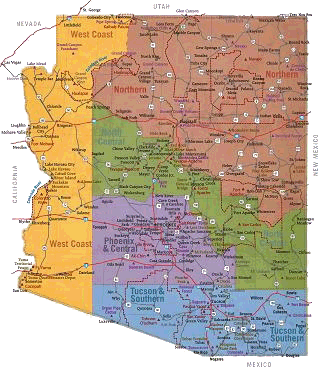Wildlife Viewing in September
Phoenix and Central Arizona
South Mountain Environmental Education Center
10409 S Central Ave, Phoenix, AZ 85042
(623) 334-7880
Migrant songbirds are quieter, and so are the trails of South Mountain park near Phoenix, especially on “Silent Sundays” which encourage non-motorized access to park roads. Arrive early in the morning and you’ll hear the “gur-gur-gur-gur” of a cactus wren calling from a cholla (some describe this call as sounding like a car that won’t start). Listen for the emphatic “wheewheeet!” of a curve-billed thrasher. Boyce Thompson Arboretum celebrates the seasonal migration season with the “Bye Bye Buzzards” event, a quirky seasonal salute to turkey vultures before these impressive birds depart to spend winter months in southern AZ and Mexico. County parks offer nighttime events such as the Full Red Moon walk, and nights are warm enough in September for a final opportunity to see a late-season Gila monster foraging to fuel up before winter hibernation. Check out the South Mountain Environmental Education Center, and nearby Javelina Canyon gives hikers a chance to see the namesake, distinctly Sonoran Desert mammals. Fat Man’s Pass is another hike popular with wildlife watchers.
Northern Arizona
The Arizona Game and Fish Department holds public elk-viewing tours at their Sipe White Mountain Wildlife Area in September; however, any open meadows throughout the forests in the central Arizona high country may offer glimpses of these tawny brown animals. Also around the White Mountains and Rim Country, fall bird migration begins in late August and can last through early November. Bald Eagle sightings increase with the wintering population of approximately 200 birds. Virtually any open body of water with good perching trees or snags can hold one or more eagles, as they appear to patiently await their opportunity to feed on some unlucky waterfowl. Look for eagles at River Reservoir in Greer, Luna Lake in Alpine, Becker Lake in Springerville, the myriad of lakes in the Pinetop-Lakeside and Show Low areas, and at any of the Mogollon Rim lakes and lakes in the Prescott area.
Rocky Mountain bighorn sheep are also one of the White Mountain’s signature big game species. Forest Road 25 descends from Wildcat Point to Wildcat Crossing; look in the canyons and along slopes for the white rumps of sheep as they feed among the trees. Travel the scenic Coronado Trail (State Highway 191) from Clifton to what remains of the old town of Stargo (located a few miles north of Morenci) and you can spot sheep close to the roadway along the slopes of the vast open-pit copper mine that wraps around Morenci. Drive slow - during the sheep rut in November and December, the large, 300-pound rams are constantly on the move as they seek receptive ewes.
Tucson and Southern Arizona
As the monsoon rains come to an end, migrant birds gather en masse with large numbers of Swainson's hawks soaring in huge kettles as western kingbirds and swallows line up on powerlines. Shorebirds abound at ponds and lakes and mixed flocks begin to form in the mountain canyons as summer breeders begin moving down slope. Lowland desert areas host congregations of mixed species as migrants start heading south. Early wintering species like green-tailed towhees and sparrows begin to arrive. Autumn’s onset is also a good time to try for a “skunk trifecta:” see if you can find three species of them including the most common striped skunk and its less common cousins the spotted and hooded. Skunks prefer habitat close to water, so look for these around dusk and dawn in the Patagonia-Sonoita region – and try to score an extra point by seeing a hog-nosed skunk!














